International Heritage Centre blog
“Such a candle as I trust shall never be put out”: The Salvation Army and the Reformation
“Such a candle as I trust shall never be put out”: The Salvation Army and the Reformation
On 31 October 2017 it is 500 years since Martin Luther (probably) nailed his 95 theses to the door of the Schlosskirche in Wittenberg and, in so doing, began the progress historians call the Protestant Reformation. The Salvation Army, founded in 1865, is clearly a little younger than the Reformation but has very much seen itself in a tradition from the Protestant Reformers, such as Luther and John Calvin, via later revivalists such as John Wesley, down to William and Catherine Booth. This tradition is evident in the articles about the Reformation and key reformers in various Salvation Army periodicals, where it is also possible to track developments in The Salvation Army’s own relationship with the legacy of the Reformation.
In this anniversary year, The Salvation Army’s magazine for Officers, called The Officer, has carried a number of articles about the Reformation, including retired General Shaw Clifton’s ‘An Event with Hammer and Nails: The legacy of Martin Luther’ (Sep-Oct 2017), in which he reminds us that his own first article for The Officer, written in 1974, was about Luther’s teachings (‘Martin Luther and the Priesthood of all Believers’, which Clifton followed up in January 1976 with ‘John Calvin and Self-Denial’). The 1970s and 1980s also saw a steady stream of articles looking back at the Reformation including ‘The Army and The Reformation’ in 1976, an article on the theology of John Knox in 1980 and ‘The Abiding Importance of Luther’ in 1982. In 2010 Captain Michael Ramsay wrote about Ulrich Zwingli (“the third man of the reformation”) and his movement away from a sacramental theology, concluding that “in many ways Zwingli would have made a good Salvationist.”
As well as a complete set of The Officer magazine beginning in 1893, The Salvation Army International Heritage Centre holds a wide range of Salvation Army periodicals, including All the World where an early reflection on the Reformation can be found in December 1889, when Major Elwin Oliphant contrasts the priorities of the Reformers with The Salvation Army’s “thirst for the souls of men:”
“I have often wondered, when reading the history of the Reformation, why the reformers did not aim more at the personal salvation of the people rather than at preaching certain doctrines […] I say nothing of their spotless lives, of their martyrdom for the truth, of their undaunted courage against the superstitious mummeries of their day; but there are the Wesleys and the Whitfields of Denmark, who counted all as nought if souls were not soundly converted to God?”
But The Officer magazine has the strongest tradition of any Salvation Army periodical for articles looking back to the early years of the Reformation. The first references to Martin Luther in its pages are taken from the works of others, such as the review of the Rev. John Vaughan’s Life Stories of Remarkable Preachers in June 1894, and in June 1897 a description of ‘Luther before the Diet of Worms’ is taken from Jean-Henri Merle d'Aubigné’s History of the Reformation of the Sixteenth Century.
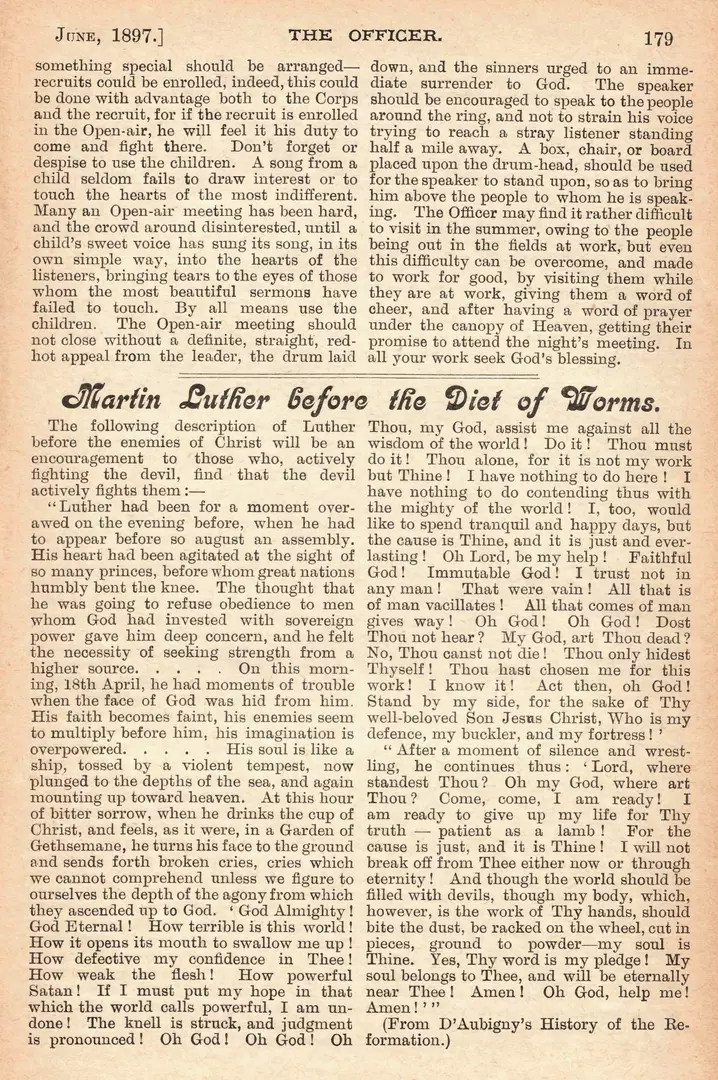
The Officer has also run long series of themed articles, one of which, ‘Characteristics of Past Soul-winners,’ included the first article in the magazine to address the Reformation directly. This was the second installment in the series, in April 1899, focusing on John Knox (the first installment had looked at the puritan Richard Baxter). The unnamed author writes that “the Reformation is the greatest event in the history of civilisation since Paganism gave place to Christianity” and refers to Knox as “the Luther of Scotland” and “while not called to copy their doings, let us imitate their bold and fearless spirit and noble self-sacrifice.” The longest such series was the 35-part ‘Moral Lessons from the Lives of Great Men’ which began in January 1906 with Alexander the Great and (having taken in Benjamin Franklin, Demosthenes and John Chrysostom) ended in June 1909 with the Baptist missionary William Carey. The ‘Great Men’ included a number of Reformers: John Knox (No 6, September 1906), Martin Luther (No 13, April 1907), George Wishart (No 23, June 1908) and William Tyndale (No 29, December 1908). The series also included one of the leading figures of the Counter Reformation, Ignatius Loyola (No 27, November 1908), from whose life “there are many useful lessons- lessons in enterprise, earnestness, and determination.” This article also made an assessment on the later years of the Reformation: “The Reformer’s movement became lukewarm and worldly, while the grand old leaders, as they were borne to their graves, left no successors behind them.” The article on Luther earlier in the series also laments that “one of the mysteries of history [is] that noble and good work can be thwarted, and, as it seems to us, destroyed. The stream of the history of good does not flow straight onwards to the sea, but twists and turns upon itself in many a curve.”
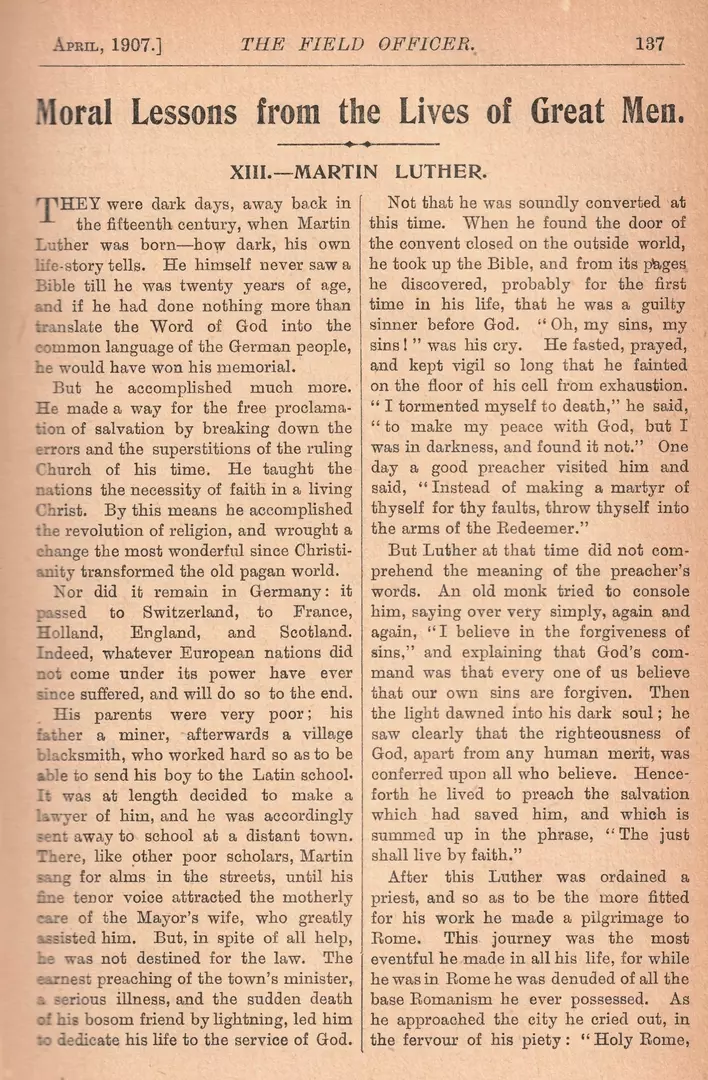
‘Moral Lessons from the Lives of Great Men’ also included some earlier religious leaders who had a significant impact on the Reformation, including Savonarola (No 5, August 1906) and John Wyclif (No 16, July 1907). Other articles have also looked back to key figures of the pre-reformation such as the Bohemian religious leader Jan Hus, whose vision while imprisoned is reported as a ‘Pointed Illustrations’ in November 1899, closing with the quote from Pope Adrian that “The heretics Huss and Jerome appear to have come to life again in the person of Martin Luther”. Hus also features, alongside John Wesley, George Fox and John Bunyan, (described as people “who in all ages have tried to do the same kind of work that I am now trying to do”) in an article on “Some of My Immortal Friends” by Brigadier Matilda Hatcher in April 1926.The English Reformer, Hugh Latimer appears in articles of August 1909, as ‘The Fearless Preacher,’ and September 1920, subtitled ‘A Brief Account of the Life of One of the Leaders of the Reformation’. The latter article also looks at the career of his Thomas Bilney, who led Latimer to Protestantism. In an article about ‘Personal Testimony and Personal Effort’ in The Staff Review for October 1931, Commissioner Johanna van de Werken uses the example of “Thomas Bilney winning by personal effort the great bishop-martyr, Hugh Latimer.”
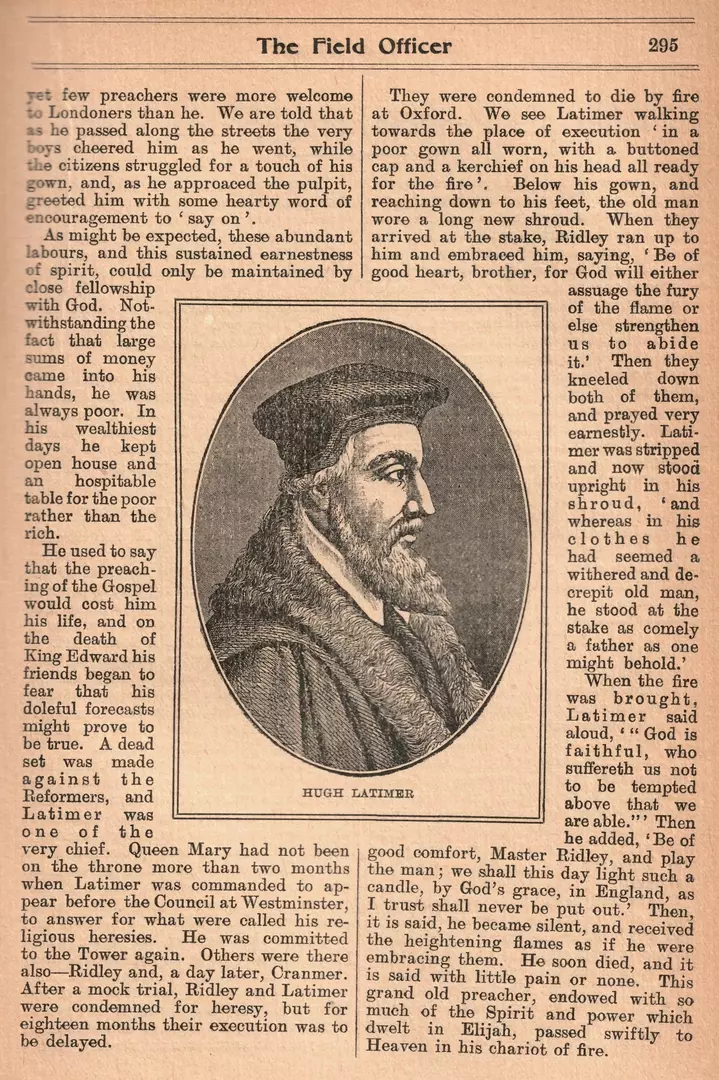
In October 1967 Lt-Colonel Thomas Jewkes visited Wittenberg, then in East Germany, for the 450th Luther anniversary and wrote of the experience in his article for The Officer in Sept-Oct 1968, ‘The Cross at Wittenberg- 1967.’ This year’s Reformation 500 celebrations coincide with the centenary of the Communist revolution in Russia, and likewise Jewkes wrote that in 1967 the “Church celebrations coincided with the Rother Oktober (Red October) celebrations. Great banners proclaimed ‘On the 50th Anniversary we thank the people of the Soviet Union’ [and] ‘Communism will Conquer the World’” and “the proprietors of shops and public buildings, in their enthusiasm, displayed the pictures of Luther and Lenin side by side.” Jewkes writes of Luther being “conscripted for the class war” and the East German authorities “regard[ed] the Reformation as the beginning of the early ‘burgerlich revolution’.” He also reflects on his own presence as a uniformed British Salvationist in a country where The Salvation Army had been banned since the end of the Second World War.The Heritage Centre brings the story of The Salvation Army and the Reformation up-to-date as we hold documents relevant to the 500th anniversary. On 15-19 October 2017, The Salvation Army held a theological symposium in Wittenberg called ‘Salvationists at the Wittenberg Door’ and an accession of the papers delivered at the conference (including ‘Luther: a Life that Changed the World’ by Lt-Colonel (Dr) Geoff Webb and ‘Salvationist Theology Today in the Light of Luther’s Teaching’ by Commissioner (Dr) Gudrun Lydholm) comprises one of the most recent accessions into our archive.
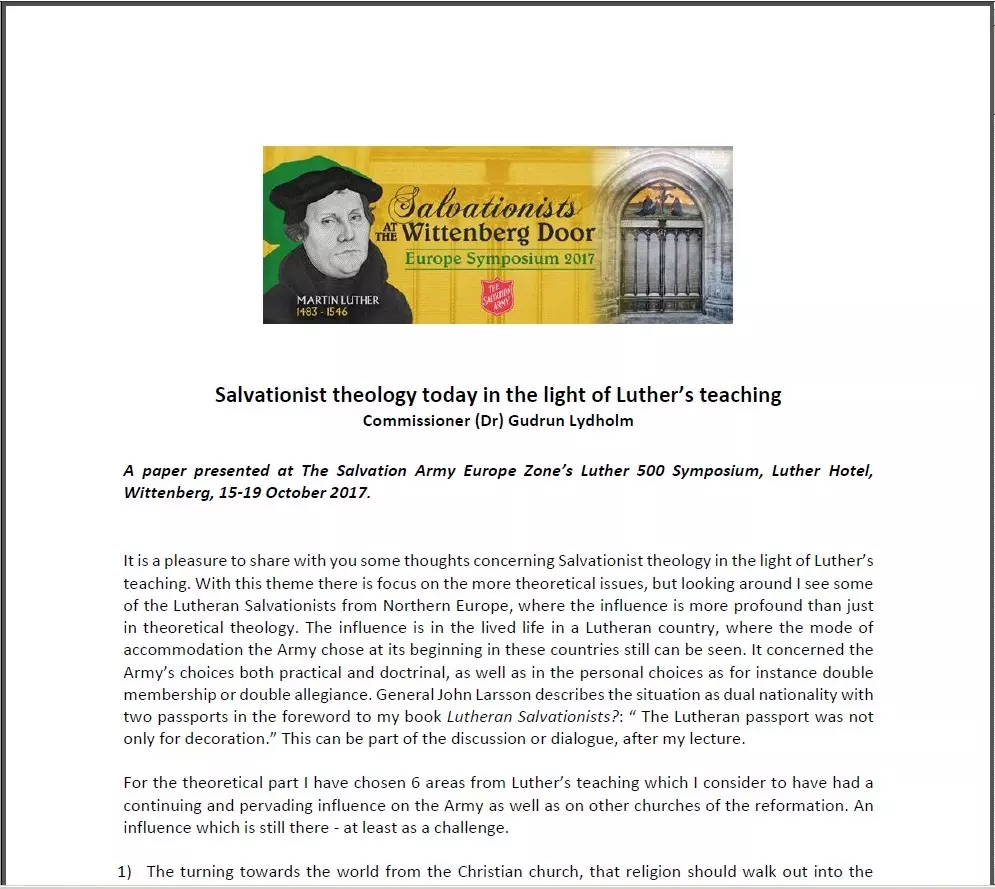
Steven
October 2017
Read other blogs from the Heritage Centre
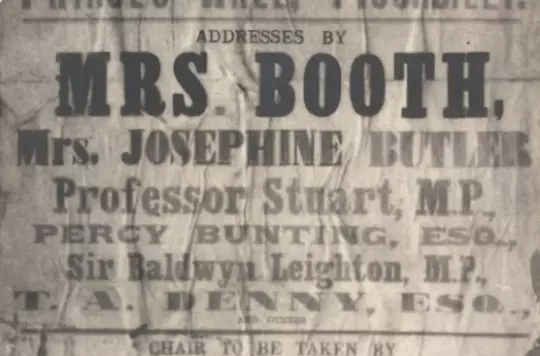
Josephine Butler, Florence Booth and 'The Maiden Tribute of Modern Babylon'
Identified by some as 'the patron saint of prostitutes', Josephine Butler inhabits an integral place among first wave feminist reformers...

Voices of civilian internment: Salvation Army archives on Cambridge Digital Library
This August saw the launch of 'Voices of civilian internment: WWII Singapore', a new collection of digitised archive material...

Riches indeed!
Our new Research Assistant, Major Mel Jones, gives his first impressions of working at the Heritage Centre...
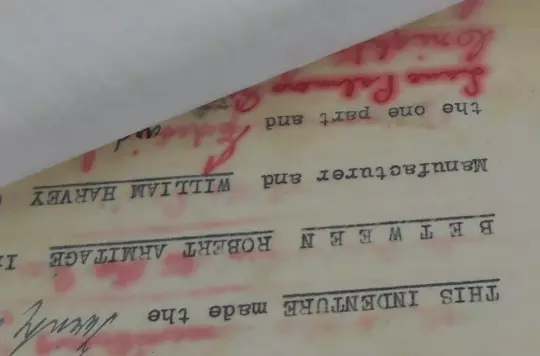
Conserving the Leeds Guardian Home papers
In 2013, I opened a box of records that had come to us after many years spent in various unsuitable storage locations...